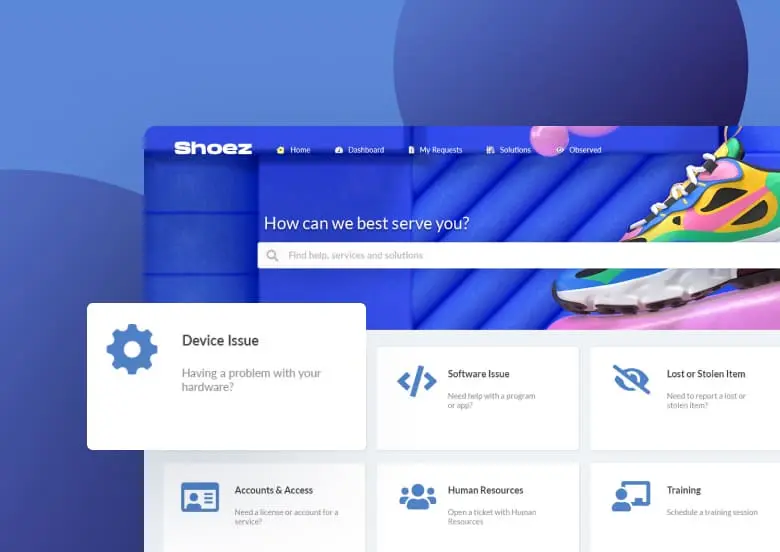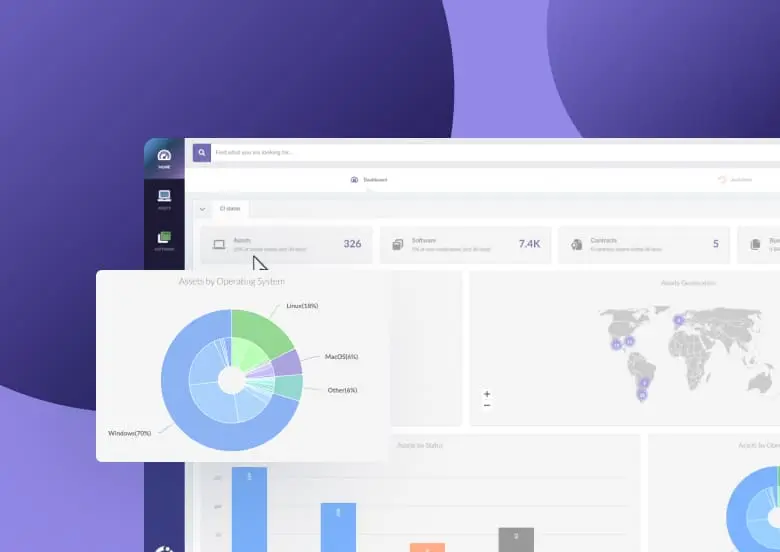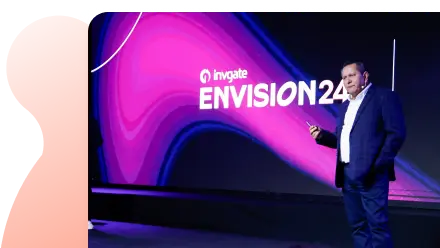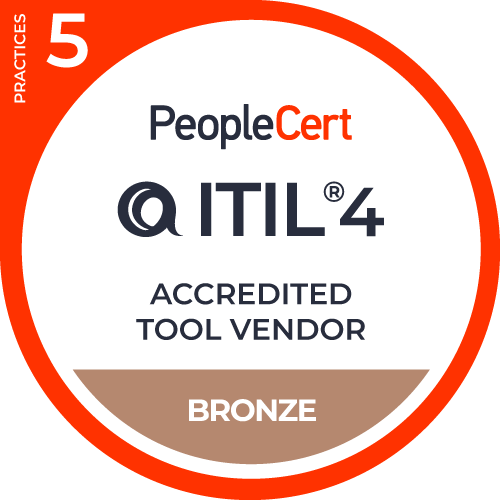Ever wonder what happens to all those old computers and smartphones when businesses upgrade their tech? It's not as simple as tossing them in the trash. Enter the world of IT asset disposition, or ITAD for short.
This growing field focuses on responsibly managing the lifecycle of technology equipment, from reuse to recycling. It's a crucial process that balances data security, environmental concerns, and regulatory compliance.
In this article, we'll explore the ins and outs of ITAD. We'll look at why it matters, how it works, and what organizations need to know to handle their IT assets effectively. We will also show you some of InvGate Asset Management's features that can help you with the process.
Let's get started!

What is ITAD?
IT asset disposition refers to the practice of responsibly managing the end-of-life cycle for IT equipment. This process encompasses reusing, recycling, repurposing, repairing, or disposing of unwanted IT assets in an environmentally conscious and secure manner.
The importance of ITAD extends beyond simple waste management. By reusing components from outdated devices, ITAD helps keep harmful materials like plastics and heavy metals out of landfills and ecosystems. Organizations can handle ITAD internally or partner with specialized vendors who offer expertise in secure data destruction and eco-friendly e-waste recycling.
ITAM provides the necessary tracking and documentation of assets throughout their lifecycle, which ensures accurate and secure disposal during ITAD. An ITAM tool aids ITAD by offering comprehensive records and insights into asset status, ensuring efficient and compliant disposal processes.
ITAD in the larger context of ITAM and Lifecycle Management

To fully understand ITAD, it's helpful to see where it fits within the broader scope of IT Asset Management (ITAM) and ITAM Lifecycle Management.
ITAM is a set of practices that helps organizations manage and optimize their IT assets, from acquisition to disposal. It includes:
-
Planning and procurement
-
Deployment and usage
-
Maintenance and upgrades
-
Retirement and disposal
ITAD represents the final stage in this lifecycle. However, effective ITAD actually begins much earlier in the process. Organizations need to consider end-of-life strategies from the moment they acquire new assets.
Integrating ITAD into their broader ITAM and Lifecycle Management strategies, organizations can:
-
Improve budgeting and forecasting for technology refreshes.
-
Enhance security by planning for data destruction from the outset.
-
Maximize the value of IT investments through strategic reuse and recycling.
-
Ensure consistent, policy-driven approaches to asset retirement.
An ITAM tool can help with ITAD by providing detailed records of assets, ensuring that no data is missed during the disposition process and facilitating compliance with regulatory compliance.

IT Asset Lifecycle Management: The 9 Stages to Manage Your IT Assets
The importance of secure ITAD
Protecting brand reputation
Implementing a robust ITAD strategy is crucial for safeguarding a company's brand reputation and financial interests. Organizations can maximize their return on investment by prioritizing compliance and data security throughout the disposition process while minimizing potential risks.
ITAD solutions, which commonly fall under the scope of ITAM software, can be tailored to meet specific business needs, considering factors such as asset types, data sensitivity, and operational processes. These customized approaches help companies recover value from outdated technology while protecting their brand from potential security breaches or environmental missteps.
Data security: a top priority
One of the most critical aspects of ITAD is ensuring data security. Improper disposal of IT assets can lead to devastating data breaches, exposing sensitive information and potentially violating numerous regulations.
ITAD providers employ various methods to guarantee complete data erasure, including:
-
Physical destruction of hardware
-
Degaussing (erasing magnetic media)
-
Specialized software for secure data wiping
These processes help prevent unauthorized access to sensitive data, even after the equipment has left an organization's control.
Regulatory compliance
Properly handling data during IT asset disposition is not just good practice—it's often a legal requirement. Several major laws in the United States govern data protection, including:
-
Privacy Act of 1974
-
Fair and Accurate Credit Transactions Act (FACTA)
-
Gramm-Leach-Bliley Act (GLBA)
-
Health Insurance Portability and Accountability Act (HIPAA)
-
California Consumer Privacy Act (CCPA)
For example, careless disposal of Personally Identifiable Information (PII) is subject to harsh legal penalties in many countries, and companies without regimented processes for technology retirement and data disposal risk losing reputation, trust, and revenue.

The IT Compliance Management Process: Steps, Roles, And Main Tasks
Environmental benefits of sustainable asset disposal
Beyond data security, ITAD plays a crucial role in promoting environmental sustainability. Responsible IT asset disposal methods include:
-
Refurbishing and reselling viable equipment
-
Recycling components for use in new products
-
Proper disposal of hazardous materials
These practices contribute to a circular economy, reducing electronic waste and conserving valuable resources.
ITAD in practice
Organizations looking to implement ITAD strategies have several options. They may choose to develop internal processes or partner with specialized ITAD providers.
Many ITAD companies offer comprehensive services, including:
-
Asset inventory and valuation
-
Secure transportation and chain of custody
-
Data sanitization and destruction
-
Environmentally responsible recycling
-
Detailed reporting and certificates of destruction
Some ITAD providers also coordinate with each other to maximize the value of retired assets, creating a network that efficiently redistributes usable equipment.
Evaluating ITAD services and providers
-
When choosing an ITAD company, consider factors such as the company’s reputation, data destruction methods, and environmental sustainability.
-
IT organizations should research the company’s certifications, such as R2 or e-Stewards, to ensure they meet industry standards.
-
Consider the company’s ability to handle the volume of equipment and data you need to dispose of.
-
Look for companies that provide transparent reporting and auditing to ensure accountability.
How can InvGate Asset Management help with ITAD
As previously mentioned, specific ITAM software is your best ally throughout the entire IT Asset Lifecycle Management process, including IT asset disposal.
For this, InvGate Asset Management offers several features to automate this process:
-
Health Rules: These rules determine the status of an asset based on its criticality to your company’s regulatory compliance. The rules are customizable and use a color code: green for safe devices, yellow for devices with warnings, and red for devices in critical status. This will help you make informed decisions as when assets are ready for disposal.
-
Smart Tags: You can create tags with specific rules that are automatically assigned to assets meeting those criteria. This feature helps reduce equipment downtime by alerting you to issues or changes as soon as they occur.
-
Automation: This feature allows you to create rules and triggers that respond to specific actions. It offers a wide range of possibilities, from sending email notifications to changing fields on an asset when you take an option.
All these function enable IT teams to keep a close eye on their environment, making informed decisions throughout asset's complete lifecycle and ensuring costs and performance are optimized.
Best practices for ITAD
Developing an effective ITAD program
Creating a robust IT asset disposition program requires careful planning and execution. Key elements of an effective ITAD strategy include:
-
Clear disposition policies
-
Secure data handling procedures
-
Environmental sustainability goals
-
Compliance with relevant regulations
Organizations should start by conducting a thorough inventory of their IT assets, including hardware specifications, age, and current value. This inventory forms the foundation for making informed decisions about when and how to dispose of equipment.

How to Get a Unified IT Asset Inventory in 24 Hours
Implementing ITAD policies and procedures
Once an inventory is established, organizations can develop specific policies and procedures for IT asset disposition. These should address:
-
Data security protocols
-
Chain of custody documentation
-
Environmental sustainability requirements
-
Vendor selection criteria
Clear guidelines help ensure consistency across the organization and minimize the risk of data breaches or regulatory non-compliance. Regular training for employees involved in the ITAD process is essential to maintain adherence to these policies.

7 Steps to Develop an Effective IT Asset Management Strategy
Measuring and reporting ITAD sustainability metrics
To gauge the effectiveness of an ITAD program, organizations can establish and track these key performance indicators (KPIs):
-
Percentage of assets recycled or reused
-
Volume of e-waste diverted from landfills
-
Carbon footprint reduction from ITAD activities
-
Cost savings from asset value recovery
-
Number of data security incidents
Regular reporting on these metrics helps organizations demonstrate the value of their ITAD program to stakeholders and identify areas for improvement.
Future of ITAD and its importance in the industry
The ITAD industry continues to grow in importance as technology proliferates across all sectors of the economy. Looking ahead, several trends are likely to shape the future of ITAD:
-
Increased focus on data privacy and security
-
Growing emphasis on circular economy principles
-
Adoption of advanced technologies for asset tracking and data erasure
-
Expansion of ITAD services to cover a broader range of devices and equipment
Large organizations, especially those with national or global footprints, are moving towards consolidated and standardized ITAD programs. This approach allows for more consistent practices and better risk management across diverse operations.
The volume of e-waste is growing worldwide, and the role of ITAD in promoting sustainable technology will become increasingly critical. With a robust ITAD strategy, organizations can contribute to a more environmentally responsible tech industry while protecting their own interests and data security.
Key takeaways
IT asset disposition plays a crucial role in modern technology management. A well-defined ITAD program offers numerous benefits:
-
Protects sensitive data from unauthorized access
-
Ensures compliance with data protection regulations
-
Maximizes value recovery from retired assets
-
Reduces environmental impact through responsible disposal
-
Mitigates risks to brand reputation and financial stability
Regulatory requirements and corporate Risk Management needs are evolving, and ITAD programs must adapt to meet these changing demands. Organizations should seek solutions that address data security and environmental compliance throughout the disposal process.
Ask for InvGate Asset Management's 30 day free trial to see how the tool can boost your IT operations and streamline the management of assets throughout their lifecycle.















